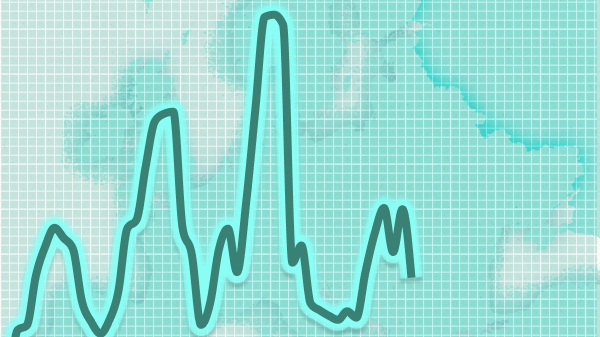Border officials documented a decline in irregular migration to Europe in 2024, primarily due to a decrease in crossings along two key routes. However, numbers are increasing in other areas, partly driven by an influx of migrants from Bangladesh, Egypt and Vietnam.
Optimieren Sie Ihre Browsereinstellungen
NZZ.ch benötigt JavaScript für wichtige Funktionen. Ihr Browser oder Adblocker verhindert dies momentan.
Bitte passen Sie die Einstellungen an.
Irregular border crossings into the EU have reached their lowest level since 2021. According to border protection agency Frontex, around 239,000 irregular crossings were registered last year, 38% fewer than in the previous year.
This sharp decline comes after three years of continuously rising figures. After hitting a low point in the pandemic year of 2020, the figures rose to a peak in 2023, with as many as 55,000 irregular border crossings per month recorded between August and October. At that time, most arrivals were taking the Central Mediterranean route from Africa to Italy or the Western Balkan route via Hungary and Austria.
Last year’s decline was in part due to the fact that significantly fewer people entered Europe via these two routes. In 2023, around 162,000 migrants arrived in Italy without legal permission, while 98,000 took the Western Balkan route. In 2024, these figures respectively fell to 67,000 and 22,000.
One factor contributing to the decreasing number of migrants taking the Central Mediterranean route has been Tunisia’s ongoing efforts to block crossings to Italy. In July 2023, the EU struck a migration agreement with Tunisia, under which the country committed to stemming migrant departures via boat in exchange for financial support worth millions. Countries such as Serbia and Montenegro have also tightened their border controls and introduced visa requirements for citizens of various countries including India, Tunisia and Cuba. An increasing number of migrants from these countries had entered the EU via the Western Balkan route in 2023.
Too early to speak of reversing trends
It remains to be seen whether these measures will lead to a lasting shift Europe-bound migration pattens. Similar agreements have also been concluded in other regions, leading to tightened border controls. Morocco, for instance, has received more than 1 billion euros from the EU and Spain since 2014 in return for agreeing to combat irregular migration. An agreement worth billions of euros has also been in place with Turkey since 2016.
In spite of this, the largest share of migrants arriving in Europe illegally in 2024 came via the Eastern Mediterranean route, traveling to Greece from Turkey. Most came from Syria or Afghanistan. However, an increasing number of people are also migrating from Egypt, which is undergoing a severe economic crisis, setting sail from eastern Libya and heading for Cyprus or Greece. The Eastern Mediterranean route also served as the most popular path for women arriving in Europe irregularly in 2024. Although the proportion of women among migrants entering the EU without permission remained constant at around 10%, two-thirds of them used this route.
Despite the declines elsewhere, the number of irregular arrivals in Spain reached a new high last year. While relatively few migrants reach Spain via Morocco, the stricter measures taken by border control authorities there have led to a shift in migration flows to the West African coast.
In 2024, around 47,000 people reached the Canary Islands from Mauritania or Senegal, the highest such number since Frontex began collecting data in 2009. The route, which is considered the most dangerous migration pathway to Europe, is mainly used by people from war-torn Mali, or by citizens of Senegal or Morocco. According to the International Organization for Migration, at least 1,200 people died trying to make this crossing in 2024.
Ukrainian men and migrants from Asia
The coast of West Africa is not the only sea route which poses considerable dangers to migrants, however. Rubber dinghies also regularly capsize when crossing the English Channel. Last year, the route from France to the U.K. became the second most frequently taken irregular migration route in Europe. Notably, authorities have seen rising numbers of Vietnamese migrants arriving in the U.K. in this way, lured by the promises of traffickers on social media or by success stories among friends and acquaintances. According to research conducted by the BBC, many such migrants fly legally to Hungary under the pretext of a temporary work stay, and then travel on to France illegally.
European border control authorities are observing similar patterns among migrants from Bangladesh, who have been arriving in Italy in large numbers for years via the Central Mediterranean route. Italy has now become home to a large diaspora of Bangladeshi natives. Many first travel to Egypt, and then enter the EU via Libya or Tunisia.
The largest relative increase in irregular border crossings in 2024 was recorded far from the EU maritime borders, however. The number of irregular entries via the Eastern Borders route to Poland and the Baltic States rose from 5,800 to 17,000. However, the majority of these crossings were not due to the organized trafficking of African migrants via Belarus, but to thousands of men from Ukraine who presumably wanted to escape compulsory military service.
In view of the many challenges produced by the various migration routes into the EU, Frontex Executive Director Hans Leijtens warns that the dynamics of migration change every year. He adds that these shifts will «require constant vigilance and adaptability» despite the declining numbers seen in 2024. The situation in the Middle East, for instance, remains volatile. Moreover, the world’s largest group of displaced persons – numbering about 12 million refugees – is currently located in the region around Sudan. Members of this population have not yet sought to come to Europe in large numbers.
Latest articles
Global reporting. Swiss-quality journalism.
In today’s increasingly polarized media market, the Switzerland-based NZZ offers a critical and fact-based outside view. We are not in the breaking-news business. We offer thoughtful, well-researched stories and analyses that go behind the headlines to explain relevant events in the U.S., in Europe and worldwide. To produce this work, the NZZ maintains an industry-leading network of expert reporters around the globe who work closely with our main newsroom in Zurich.
Sign up for our free newsletter or follow us on Twitter, Facebook or WhatsApp.
Source link : http://www.bing.com/news/apiclick.aspx?ref=FexRss&aid=&tid=678fbfeab53b46d5aa1f4f234f395477&url=https%3A%2F%2Fwww.nzz.ch%2Fenglish%2Firregular-migration-to-eu-showed-sharp-decline-in-2024e-ld.1866535&c=200845862070881135&mkt=de-de
Author :
Publish date : 2025-01-17 03:41:00
Copyright for syndicated content belongs to the linked Source.


